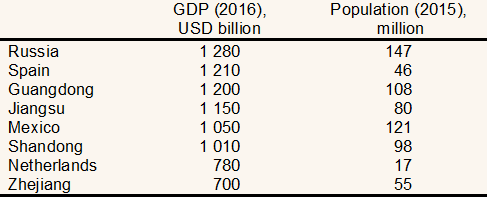BOFIT Weekly Review 2017/12
Guangdong, China's largest province, has an economy as big as Spain's
After almost four decades of rapid growth, some Chinese provinces have GDP numbers like those of mid-sized national economies. China's National Bureau of Statistics reports that the nominal GDP of Guangdong province last year reached $1.2 trillion, putting it size-wise on par with the Spanish economy and approaching Russian GDP. China's second-largest provincial economy, Jiangsu, had a GDP larger than Mexico's, while number-3 Shandong province's GDP was nearly as large as Mexico's. Looking at China's megalopolises, both Beijing and Shanghai had larger economies than either Hong Kong or Singapore.
China's provincial GDP data should be viewed with considerable caution, however. Much of the problem arises from the fact that provinces are expected to hit their hard growth targets. Failure to do so can be harmful to the career trajectories of regional leaders. Provincial administrations, which have strong connections with both regional firms and financial institutions, are well positioned to support economic growth. When this is still insufficient, however, officials may resort to falsification of their statistical data. Aware of the problem, the NBS has long performed its own surveys with a view to confirming or adjusting the figures reported by provincial officials. Like in previous years, the combined reported provincial GDP figures last year were slightly larger than the official national GDP figure.
Growth targets have also become increasingly difficult to achieve in recent years, especially for provinces involved in traditional heavy industries. In January, officials uncovered an unprecedented case of widespread statistical fraud in the Liaoning province. The latest NBS figures slash Liaoning's GDP figures by about 23 %. Liaoning is unlikely to be the sole province guilty of fabricating statistical data. The Financial Times reported last week that the reported GDP figures of four other provinces traditionally engaged in heavy industry (Hebei, Shaanxi, Shanxi and Inner Mongolia) were surprisingly strong in 2012–2016, even as output volumes of their main products declined and prices fell.
GDP and populations of select Chinese provinces and nations

Sources: CEIC, Macrobond and IMF.